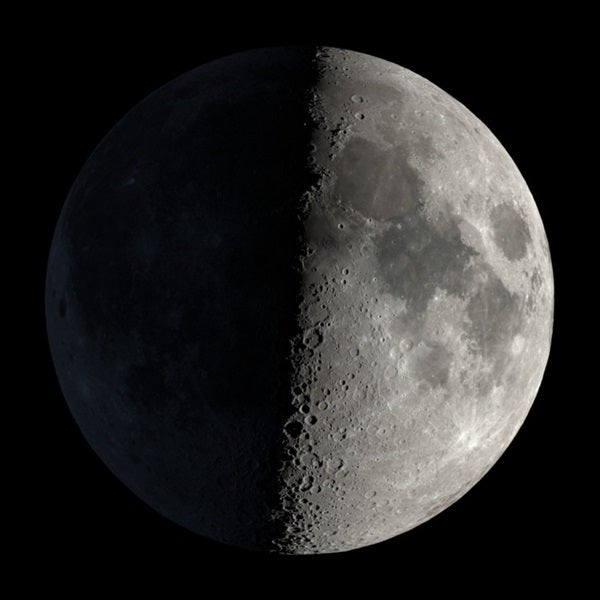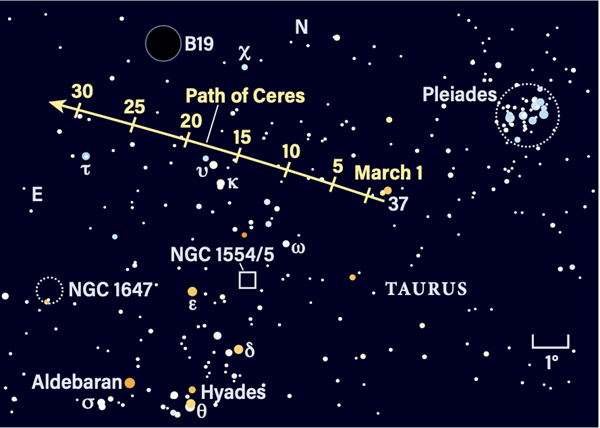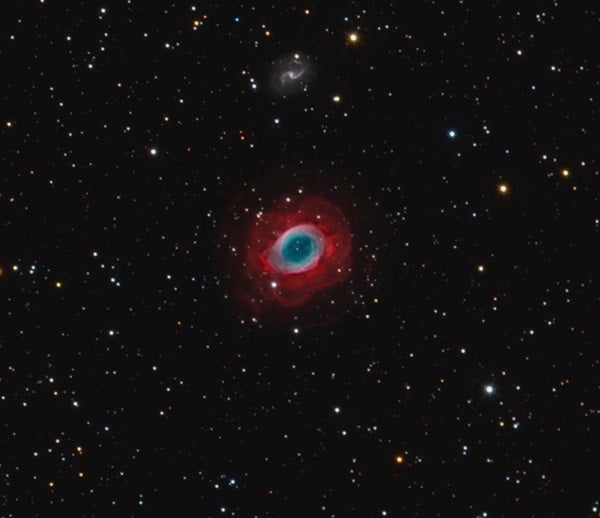Friday, March 4
With only a sliver of a crescent Moon in the sky this evening, it’s the perfect time to go comet hunting. 19P/Borrelly is currently around magnitude 9.5 in the constellation Aries. You’ll find it slowly sinking in the west after sunset. Wait until the sky gets dark, then point your scope toward the Ram, using magnitude 3.6 Bharani (41 Arietis) in northeastern Aries as a guidepost. Tonight, Borrelly is just 2.3° south-southeast of this star.
Comet Borrelly will be a challenge in smaller scopes (4 inches) but easier in a 6-incher under dark skies. Crank up the magnification to see whether you can discern that the northern edge of the coma is more sharply defined, while the comet’s short, stubby tail stretches south. Borrelly will be visible all month, although its magnitude is fading and a bright Moon will wash it away for two weeks in mid-March. You can come back to get some of your last good views later in the month; after that, it’s a 6.8-year wait for the comet to return. But that wait will be worth it — Borrelly’s December 2028 apparition promises to be a favorable one.
Sunrise: 6:28 A.M.
Sunset: 5:55 P.M.
Moonrise: 7:46 A.M.
Moonset: 8:13 P.M.
Moon Phase: Waxing crescent (5%)
*Times for sunrise, sunset, moonrise, and moonset are given in local time from 40° N 90° W. The Moon’s illumination is given at 12 P.M. local time from the same location.
Saturday, March 5
Jupiter is in conjunction with the Sun at 9 A.M. EST. It will remain invisible for a few weeks to come, reappearing in the sky toward the end of the month and visible just before dawn.
While the king of the planets remains unavailable, let’s focus on the next in line. Saturn rises roughly an hour before the Sun and stands some 5° high in Capricornus with 30 minutes to go until dawn. The ringed planet glows a soft magnitude 0.7 — still one of the brighter points of light in the twilight sky. With a telescope, Saturn’s disk now spans 15″, while its rings stretch just over twice that.
The planet currently sits just less than 4° east of Mercury (magnitude –0.2). Over the coming days, the smaller planet will quickly pull away, sinking toward the horizon even as Saturn rises earlier and soars higher at the same time each subsequent day.
Sunrise: 6:27 A.M.
Sunset: 5:56 P.M.
Moonrise: 8:09 A.M.
Moonset: 9:18 P.M.
Moon Phase: Waxing crescent (10%)
Sunday, March 6
Return to the morning sky today to check on Venus and Mars, which are drawing together for a close pass in a little less than a week. Today, they straddle the border between Sagittarius and Capricornus, with Mars in the latter and Venus in the former.
Let’s start with Venus, which shines a bright magnitude –4.7 — unmatched in the morning sky. Half an hour before sunrise, it’s nearly 20° high. Through a telescope, its 29″-wide disk is 42 percent lit. Keep an eye on the planet as the month progresses to watch it wax over time, reaching 50 percent on the 20th — the same day Venus reaches its greatest elongation west of the Sun (47°).
Mars, meanwhile, is a much fainter magnitude 1.2. It sits south of Venus and is just over 13° high 30 minutes before sunrise. The Red Planet’s disk is nearly full (94 percent lit) and spans a mere 5″, so distinguishing features is all but impossible. Still, its distinctive red color remains noticeable as its rusty soil reflects sunlight back toward Earth.
Sunrise: 6:25 A.M.
Sunset: 5:58 P.M.
Moonrise: 8:33 A.M.
Moonset: 10:21 P.M.
Moon Phase: Waxing crescent (17%)
Monday, March 7
The Moon passes 0.8° south of Uranus, located in Aries, at 1 A.M. EST. Both are unobservable at the time, so instead step outside after sunset to catch them in the west.
By an hour after sunset, the Moon has moved on from the ice giant and now sits nearly 9° to its east. Our satellite is just 5 days old, appearing as a 28-percent-lit crescent. This is good news for those who want to observe Uranus, however, as the Moon won’t completely blot out the planet’s dim, magnitude 5.9 glow.
Uranus sits in the relatively sparse southern region of Aries. As it sets, the planet is nearly even above the horizon with 2nd-magnitude Hamal, the constellation’s brightest star. Uranus sits 11° southeast of this star, northwest of the head of Cetus the Whale to its left on the sky. Once you zoom in on its location with binoculars or a telescope, note that Uranus lies about halfway on a line drawn between two field stars of magnitude 6 and 7.4.
Sunrise: 6:24 A.M.
Sunset: 5:59 P.M.
Moonrise: 8:59 A.M.
Moonset: 11:25 P.M.
Moon Phase: Waxing crescent (25%)
Tuesday, March 8
Mercury has remained visible in the early morning sky so far this month, but it will soon be disappearing, headed for superior conjunction in April. When that happens, the planet will sit directly behind the Sun from our point of view, rendering it invisible.
For now, you can still just spot Mercury just before dawn if you have a clear view of your eastern horizon. Twenty minutes before sunrise this morning, the solar system’s speediest planet is just 3° high in the east. It’s moved into Aquarius, which currently also houses the Sun. Glowing a relatively bright magnitude –0.2, Mercury outshines its near neighbor Saturn, which is higher up (7.5°) and now just under 8° to its upper right (west). Venus and Mars are now both in western Capricornus, both roughly 20° high by this time.
Sunrise: 6:22 A.M.
Sunset: 6:00 P.M.
Moonrise: 9:28 A.M.
Moonset: —
Moon Phase: Waxing crescent (34%)
Wednesday, March 9
The Moon passes 0.3° south of the dwarf planet 1 Ceres at 2 A.M. EST. Both are below the horizon at that time, so don’t worry about getting up early today. Instead, you can find the pair high in the western sky after sunset. They are in Taurus the Bull, although the fast-moving Moon has now pulled away some 8.5° from Ceres and you can’t capture both in the same field of view.
Our satellite is nearly at First Quarter, some 46 percent lit this evening and still waxing. It lies between the magnitude 3.5 star Ain in Taurus’ face and magnitude 1.7 Elnath at the tip of the Bull’s left horn (as he’s facing us; right on the sky). Ceres sits roughly halfway between the Moon and the bright naked-eye open star cluster M45, the Pleiades. The dwarf planet is now 9th magnitude and about 2° due north of 5th-magnitude Omega (ω) Tauri.
Ceres will remain in Taurus as the month progresses, passing near the dark nebula Barnard 19 later in March. This entire region is rife with deep-sky targets, so make sure to return when the Moon has moved away and dimmed to truly take advantage of all Taurus has to offer.
Sunrise: 6:21 A.M.
Sunset: 6:01 P.M.
Moonrise: 10:01 A.M.
Moonset: 12:26 A.M.
Moon Phase: Waxing crescent (44%)
Thursday, March 10
First Quarter Moon occurs today at 5:45 A.M. EST. Our satellite also reaches apogee — the farthest point from Earth in its orbit around us — at 6:04 P.M. EST. At that time, it will float some 251, 200 miles (404,267 kilometers) away.
This phase is an excellent time to enjoy our Moon, whether you’re an experienced lunar observer or just getting started. At this time, the Moon isn’t too bright and unlike during Full Moon — when the Sun is directly over the lunar surface — sharp shadows abound, making features really stand out. Plus, diligent observers will notice that even over the course of just a few hours, these shadows will change, transforming the landscape right before your eyes. This will be most evident along the terminator separating light from dark (day from night).
Some prominent craters to look for include Cassini, Aristillus, Manilius, and Heraclitus. Pump up the magnification on your telescope to cut down on the brightness if it feels overwhelming — this will put a smaller region of the Moon in your field of view, cutting down on the reflected light entering your scope (and your eyes).
Sunrise: 6:19 A.M.
Sunset: 6:02 P.M.
Moonrise: 10:40 A.M.
Moonset: 1:27 A.M.
Moon Phase: Waxing gibbous (53%)
Friday, March 11
A few hours before sunrise, the Moon has set and the sky is perfectly dark. The constellation Lyra is some 40° high in the east and climbing, with its brightest star Vega blazing at magnitude 0.
Our target this morning lies nearly 7° southeast of Vega, between the 3rd-magnitude stars Sulafat and Sheliak. We’re looking for M57, commonly called the Ring Nebula — a planetary nebula comprising the puffed-off outer layers of a dying star. M57 appears as a small, oval patch of light at roughly 9th magnitude, best seen through a telescope. It stretches about 1′ across and astronomers believe it sits some 2,300 light-years away, although its distance is hard to pin down precisely. With a 6-inch telescope or larger, see if you can spot its namesake ring of brighter emission surrounding a region of relative darkness. If you’ve got a 9-inch scope or bigger, consider a real challenge: spotting the nebula’s central white dwarf star. You’ll need extremely high magnification and very dark skies; it’s also best to give this a try while the nebula is still high above the horizon (so, earlier in the morning, rather than later).
Sunrise: 6:18 A.M.
Sunset: 6:03 P.M.
Moonrise: 11:26 A.M.
Moonset: 2:24 A.M.
Moon Phase: Waxing gibbous (62%)












